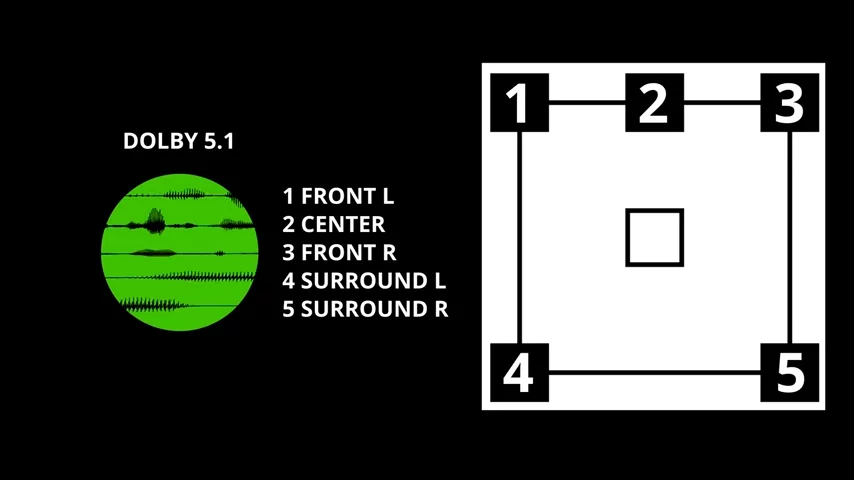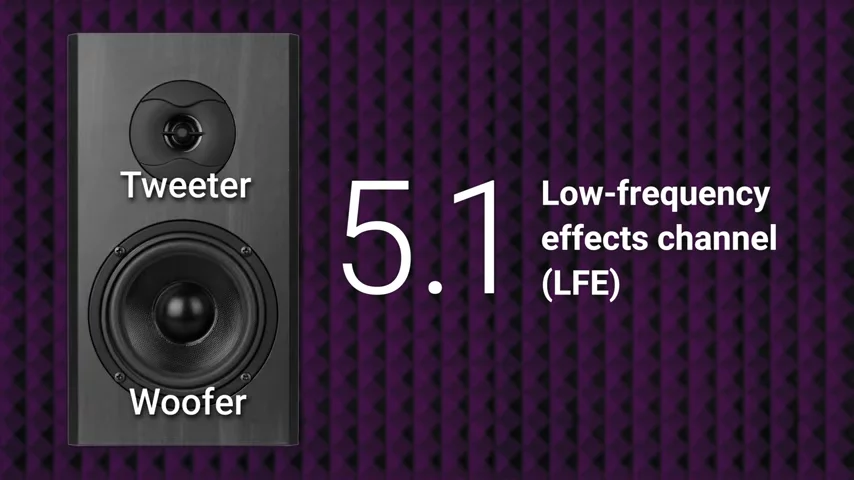Have you ever walked out of a movie theater so impressed by the audio experience that you forgot all about the 30 bucks you just dropped on popcorn and soda, and could only think about how you wish the sound could surround you at home? You run down to your local big box store and start looking for home theater equipment but pretty soon you're thrust into a disorienting vortex of numbers and dots like 7.1 and 5.1.2. So let's break down what these numbers mean.
The first number you see in the surround setup simply refers to the number of channels. Usually this refers to the number of regular speakers in your system. So a conventional 5.1 system will typically have five speakers: front left, center, front right, surround left, and surround right. Each channel can receive a separate audio signal. So if you're watching a movie that has its audio encoded in 5.1 surround, the source will likely send dialogue to the center speaker while the other speakers will play audio relative to the action on the screen for a more realistic and immersive experience.
Each channel can receive a separate audio signal. So if you're watching a movie that has its audio encoded in 5.1 surround, the source will likely send dialogue to the center speaker while the other speakers will play audio relative to the action on the screen for a more realistic and immersive experience.
By contrast, a 2.0 system simply indicates a plain old straightforward stereo setup with a left and a right channel only while 7.1 indicates two additional rear channels above a normal 5.1 for greater immersion.
But what does that 0.1 mean? The second number indicates a low frequency effects or LFE channel, which would be reproduced with a subwoofer. You see the woofers on a regular speaker typically aren't large enough or powerful enough to accurately reproduce very low frequency or low end sounds, which is why subwoofers are so often paired with speaker sets.
You see the woofers on a regular speaker typically aren't large enough or powerful enough to accurately reproduce very low frequency or low end sounds, which is why subwoofers are so often paired with speaker sets.
If you've ever used a subwoofer you'll know it only reproduces sub-base. So it's broken out as a separate 0.1 to indicate that it's not a normal speaker.
For an even better experience, you might see 0.2, maybe even 0.4, to indicate that the system supports two or more subwoofers for extra base or for a little more spatial accuracy.
Now you won't always see a third number to describe a surround set up, especially as that convention is a little newer, but if it is included this indicates overhead or height channels such as ceiling mounted or in-ceiling speakers.  Three numbers typically indicate that it's a system that supports an object based surround sound protocol like Dolby Atmos or DTS X where sounds are recorded as individual objects in 3D space instead of simple channels.
Three numbers typically indicate that it's a system that supports an object based surround sound protocol like Dolby Atmos or DTS X where sounds are recorded as individual objects in 3D space instead of simple channels.
Now you know what the numbers mean, but there are a few other points to keep in mind before you rush out to buy a new home theater setup. Remember that the numbers represent channels not speakers, and while each channel does usually get one physical speaker unit, a major exception is the ever popular sound bar. It's quite easy to find 2.1 soundbars that contain two separate sets of drivers for your left and right channels as well as a built-in subwoofer. So even though 2.1 might make you think there are three separate speakers in the box, that isn't always the case.
Similarly, the third number is present in setups that have no actual overhead speakers. Instead, there are upward firing speakers that are either built into soundbars or sit on top of your existing speakers that bounce sound off of your ceiling to simulate sounds coming from above you with mixed results.
Another important tip for the best experience is that the source material should be encoded in a way that matches your speaker setup. Although object based schemes like Atmos can scale to different numbers of speakers all the way up to 64, there's lots of content that's specifically encoded for 5.1 or 7.1, but don't worry if the encoding doesn't match your setup exactly because for example, modern receivers can easily down mix the 7.1 signal to work on just two surround speakers if you have a 5.1 setup, or up mixing a 5.1 signal to the 7.1 home theater can also be done with software like Dolby Pro Logic IIx which is found on most modern receivers and can analyze the auto signal to figure out what sound should be coming out of what speaker and when.
Or you could forget all of this stuff and just use the speakers built into your TV. I mean, they at least function, right?





















Comments (0)